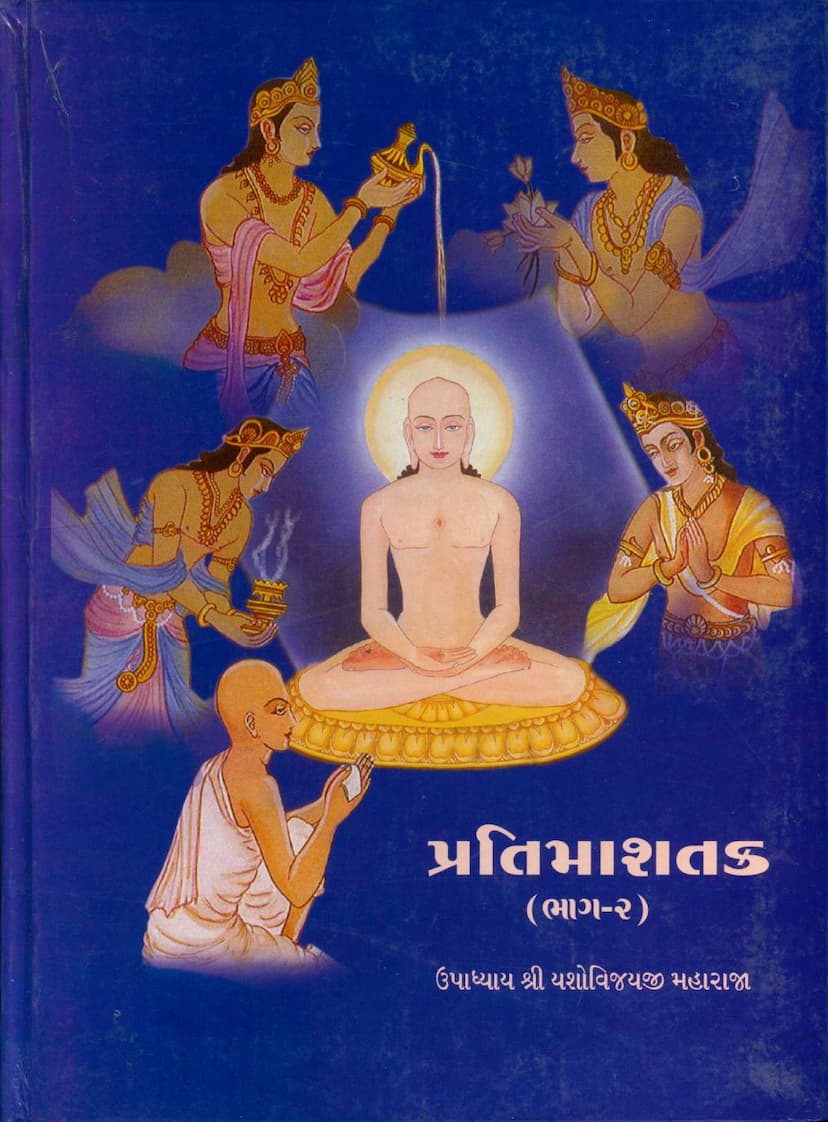Pratima Shatak Part 02
Added to library: September 2, 2025

Summary
Here's a comprehensive summary of the Jain text "Pratima Shatak Part 02" based on the provided pages:
Book Title: Pratima Shatak Part 02 (પ્રતિમાશતક - ભાગ-૨) Author: Upadhyay Shri Yashovijayji Maharaja (original text and commentary) Commentator/Analyst: Panditverya Shri Pravinchandra Khimji Mota Publisher: Gitarth Ganga Catalog Link: https://jainqq.org/explore/022183/1
Core Subject:
This book is the second part of a detailed commentary (vivechan) on the "Pratima Shatak" (प्रतिमाशतक), a Jain text authored by the renowned scholar Upadhyay Shri Yashovijayji Maharaja. The original text itself is a century of verses (shataka) dedicated to the worship and significance of Jina pratimas (images or idols of the Jinas, specifically focusing on their role in Jainism). The second part, as indicated by the content, delves into the philosophical and practical aspects of this worship, analyzing various arguments and interpretations through the lens of Jain philosophy and logic.
Key Themes and Content:
The provided pages reveal a deeply analytical and scholarly examination of Jain principles related to Pratima Puja (image worship). The commentary by Panditverya Shri Pravinchandra Khimji Mota, under the auspices of Gitarth Ganga, aims to clarify complex scriptural points and reconcile apparent contradictions.
The summary can be broken down by the progression of topics covered, as suggested by the extensive index and commentary details:
-
Dravya-stavan vs. Bhava-stavan: A significant portion of the text (as evidenced by the detailed index covering verses 30-60) focuses on the comparison and distinction between external worship (Dravya-stavan - worship of external forms like images) and internal worship (Bhava-stavan - internal contemplation and realization of the Jina's qualities). The commentary addresses questions like:
- Why do monks (yati) not engage in external worship (Dravya-stavan) while laypeople (grihastha) do?
- The comparison of Dravya-stavan to bitter medicine (katu-aushadh) for householders and its efficacy.
- The multifaceted benefits and virtues of Dravya-stavan.
- Arguments for the necessity and efficacy of image worship, even when considering potential harm to minute souls (a point often debated).
-
Philosophical Nuances and Scriptural Interpretation: The commentary engages deeply with Jain logic (naya) and explores different philosophical viewpoints to interpret the scriptures. This includes:
- Naya Vada (Theory of Standpoints): Analyzing concepts like violence (himsa) and its relation to different naya perspectives (like ṛjusūtra-naya, negama-naya, vyavahāra-naya).
- Utsarga and Apavada: Understanding general rules (utsarga) and exceptions (apavada) in Jain conduct, particularly regarding the actions of monks and laypeople.
- Scriptural Authority and Reconciliation: Addressing potential contradictions within Jain scriptures (like Mahanishith Sutra) and reconciling them through scholarly interpretation, citing various Acharyas like Acharya Haribhadrasuri.
-
Arguments for Pratima Puja: The text systematically presents arguments supporting the validity and importance of image worship:
- Comparison with Ethical Actions: Establishing the necessity of certain actions that might seem to involve harm but are ultimately beneficial or unavoidable in the pursuit of higher goals, drawing parallels like the well-digging example.
- Benefits of Jain Temples (Chaitya): Discussing the merits gained from visiting and honoring Jina temples, such as the strengthening of the vow of non-possession (aparigraha), the progress of Dharma through charity, the cessation of negative karmic tendencies, and the attainment of spiritual knowledge through the teachings of monks.
- Vayavachchhya (Service): Equating the worship of the Jina to the concept of Vayavachchhya (service to the venerable) and explaining how such devotion contributes to spiritual progress.
- Distinguishing between Types of Violence: Elaborating on the Jain understanding of violence (himsa) and how actions performed with the right intention and context, like image worship, are not considered bindingly sinful, especially when compared to the intentional violence driven by passion.
- Addressing Criticisms: The commentary tackles criticisms of image worship, particularly those stemming from other philosophical schools (like Buddhism, as mentioned in the discussions on hiṁsā) or dissenting Jain sects (like Sthanakavasi arguments against idol worship).
-
Illustrative Examples and Analogies: The text utilizes numerous examples and analogies to clarify its points, such as:
- The analogy of a well-digging for liberation.
- The story of Savadacharya and Vajracharya from the Mahanishith Sutra to illustrate scriptural authority and the consequences of misinterpretation.
- The example of the king Jitashatru being guided by minister Subuddhi.
- The concept of 'kūpa-dṛṣṭānta' (well analogy) is frequently used to explain principles.
-
Scholarly Apparatus: The commentary showcases a rigorous academic approach, evident from:
- Detailed References: Citing various Jain Agamas and commentaries (e.g., Nishiyuktij, Ppanpāsanā Sūtra, Bhagavati Sutra, Uttaradhyayana, Acharanga, Kālpasūtra, Nandi Sutra, Shodashak, Panchashaka).
- Naya Analysis: Applying different logical standpoints (naya) to interpret the scriptures.
- Correction of Textual Errors: The "Shuddhipatrak" (शুদ্ধિપત્રક) indicates a meticulous effort to correct errors in the source text based on available manuscripts.
- Poetic Devices: Identification of literary embellishments like "Mum" (मम), "Aprastuta Prashansa," and "Atishayokti" (अतिशयोक्ति).
Overall Purpose:
The "Pratima Shatak Part 02" aims to provide a comprehensive and reasoned defense of the Jain practice of image worship. It seeks to demonstrate that Pratima Puja, when performed with the correct understanding and intention, is not a contradiction to Jain principles of ahimsa (non-violence) and detachment. Instead, it serves as a vital tool for spiritual progress, helping the practitioner overcome worldly attachments, cultivate virtuous qualities, and ultimately move towards liberation. The commentary emphasizes the importance of right knowledge (samya-gyan), right faith (samya-darshan), and right conduct (samya-charitra) in understanding and performing such practices.
In essence, the book is a profound philosophical treatise that meticulously dissects Jain doctrines to elucidate the spiritual significance and practical application of image worship within the Jain path to salvation.